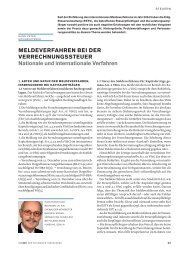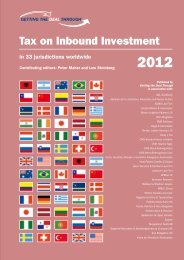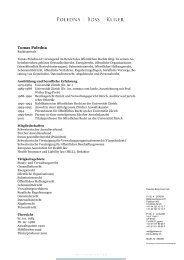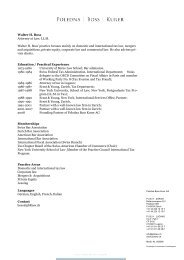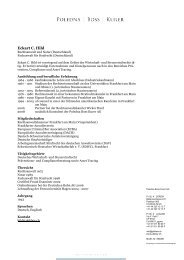Power Project Financing - Poledna | Boss | Kurer
Power Project Financing - Poledna | Boss | Kurer
Power Project Financing - Poledna | Boss | Kurer
You also want an ePaper? Increase the reach of your titles
YUMPU automatically turns print PDFs into web optimized ePapers that Google loves.
<strong>Financing</strong> of <strong>Power</strong> <strong>Project</strong>s in a Changing Environment<br />
Dr. Martin <strong>Kurer</strong>, LL.M.<br />
Attorney at Law<br />
kurer@pbklaw.ch<br />
Reto Gygax<br />
Attorney at Law<br />
gygax@pbklaw.ch<br />
Guido Alfredo A. Delgado<br />
Chairman, GAAD Inc.<br />
gaad@delgadoinc.com.ph<br />
<strong>Poledna</strong> <strong>Boss</strong> <strong>Kurer</strong> AG<br />
Zürich/Lugano<br />
P | B | K ZÜRICH<br />
Bellerivestrasse 241<br />
Postfach 865<br />
CH-8034 Zürich<br />
+41 44 220 12 12 T<br />
+41 44 220 12 13 F<br />
info@pbklaw.ch<br />
www.pbklaw.ch
General Types of <strong>Financing</strong><br />
� Balance sheet financing versus project lending (debt) or investment (equity)<br />
� Recourse lending versus non-recourse lending<br />
full recourse loan refers to the right of the lender to take any assets of the borrower if repayment is<br />
not made, limited recourse loan only allows the lender to take assets named in the loan<br />
agreement, non-recourse loan limits the lender's rights to the particular asset being financed<br />
Share issue<br />
Equity finance<br />
Retained<br />
earnings<br />
Finance<br />
Internal<br />
finance<br />
External<br />
finance<br />
2<br />
Debt finance<br />
Reserves Borrowing
<strong>Power</strong> <strong>Project</strong> <strong>Financing</strong> - overview<br />
Equity Support<br />
Agreement<br />
Sponsors<br />
Engineering, Procurement<br />
and Construction Agreement<br />
EPC<br />
Contractor<br />
Completion Guarantee<br />
Construction Guarantee<br />
Performance Guarantee<br />
O&M<br />
Contractor<br />
Government<br />
Concession Agreement<br />
<strong>Project</strong><br />
Company<br />
Operating &<br />
Maintenance Agreement<br />
3<br />
Supply<br />
Agreement<br />
Supplier<br />
Guarantee /<br />
Direct<br />
Agreement<br />
<strong>Financing</strong> and Security<br />
Agreements, PPA Assignment<br />
Lenders<br />
30% 70%<br />
PPA<br />
Agreement<br />
Offtaker / Grid<br />
Government<br />
Direct Agreement Direct Agreement Direct Agreement
<strong>Power</strong> <strong>Project</strong> <strong>Financing</strong> - Agreements<br />
� Traditionally a Concession Agreement (or <strong>Project</strong> Agreement) with a relevant government entity<br />
existed. Additionally a <strong>Power</strong> Purchase Agreement ("PPA") between the project company and the<br />
local government is in place, where the local government authority undertakes to pay for a fixed<br />
amount of electricity every year of the concession.<br />
� Following the deregulation of electricity industries, merchant power stations are being<br />
constructed. A merchant power project is a project which sells electricity into an electricity market<br />
and takes the market price for that electricity.<br />
� Merchant power projects do not normally have agreements between the project company and a<br />
government entity. Instead, they need to obtain the necessary planning, environmental and<br />
building approvals and approvals and licences to sell electricity into the market.<br />
� Without a PPA, project companies developing a power plant, and lenders, do not have the same<br />
certainty of cash flow as they would with a PPA. Therefore, merchant power projects are generally<br />
considered higher risk.<br />
� The purpose of a Direct Agreement is to provide rights to Lenders which permit the prevention of<br />
termination of key contracts executed between the SPV and other <strong>Project</strong> Parties; Lenders have<br />
the opportunity to opt to preserve the contracts by stepping in and curing the underlying<br />
termination event where the SPV has failed or elected not to do so.<br />
4
Renewable Energy <strong>Project</strong>s - Risks and Issues<br />
Renewable Energy is considered to have many benefits. However, project finance for Renewable<br />
Energy <strong>Power</strong> <strong>Project</strong>s is difficult mostly as a result of the high level of perceived risks and the higher<br />
initial cost.<br />
Specific risks include:<br />
� Land Use, Permitting and Governmental Regulation<br />
-> Habitat, groundwater, emissions regulations<br />
� Construction<br />
-> New technologies and new construction companies, higher cost<br />
� Supply (fuel or energy source)<br />
� Revenue<br />
-> Terms of power purchase agreement / market price:<br />
the lack of a clear pricing policy, and/or feed-in tariff, leads to the lack of rational,<br />
transparent, and universal <strong>Power</strong> Purchase Agreements<br />
-> Price vs cost<br />
-> Price fluctuations of certified emission reductions (CERs) / Taxation of CERs and CER revenues<br />
5
Renewable Energy <strong>Project</strong>s - Clean Development Mechanism<br />
(CDM)<br />
� Clean Development Mechanism (CDM)<br />
is one of the Kyoto mechanisms to achieve the objective of reducing Green House Gas emissions.<br />
� CDM allows emission reduction projects to generate carbon credits called<br />
“certified emission reductions” (CER) for use by the investor to generate additional cash<br />
flow<br />
6
Renewable Energy <strong>Project</strong> Returns<br />
� <strong>Project</strong>s usually achieve IRR hurdle rates only when cash flow of emission rights<br />
trading is included<br />
� ERPA (Emission Reductions Purchase Agreements ) can be used to secure revenues<br />
� Sale and purchase of CERs can be incorporated in debt finance agreements and direct agreements<br />
7
Global new investment in sustainable energy 2004 - 2009 ($bn)<br />
8
Carbon Market<br />
9
Examples<br />
Two examples of approaches to deal with the new environment<br />
� (1) Vestas Wind <strong>Project</strong> Structure<br />
� (2) Geothermal <strong>Project</strong>s in Indonesia<br />
10
Example (1): Vestas Wind <strong>Project</strong> Structure<br />
11
Example (1): Vestas Wind <strong>Project</strong> Structure<br />
Key issue:<br />
� Where does sufficient revenue to service debt in<br />
- absence of PPA„s and<br />
- in light of high investment<br />
come from?<br />
12
Example (2): Geothermal in Indonesia<br />
Combining the Carbon Market and the <strong>Project</strong> Finance<br />
Market: The Feed-in Tariff Fund for Geothermal in Indonesia<br />
GOI struggling to reduce Energy subsidies as promised in G20 Pittsburgh. Subsidy<br />
paid in 2010 > US$6.1 billion for electricity. Any RE or EE feed-in payments by GOI<br />
politically not acceptable.<br />
Least cost available alternative for PLN, the monopoly utility. (allowing it to decrease<br />
subsidy of GOI), is to build or purchase electricity from coal based power plants (IPPs)<br />
To prevent Indonesia from further locking in coal based generation and in line with<br />
principles of fast track climate change financing, the Government of the Netherlands<br />
and combined financial institutions can offer to pay a Feed-in Tariff, making<br />
geothermal and other renewable energy with significantly less CO2 emissions<br />
affordable for public and private investors.<br />
An initial analysis has shown that this is a commercially feasible proposals, assuming<br />
that repayment of the Fund would come from the expected higher cost for coal<br />
generation and sale of Carbon Emission Reduction certificates.<br />
11
Example (2): Geothermal in Indonesia<br />
PPA with PLN<br />
FIT agreement with FIT FUND<br />
Proposed Framework Agreement<br />
Price indexed to Coal Price<br />
+<br />
A fixed feed-in tariff over and<br />
above the coal price<br />
TOTAL PRICE
Example (2): Geothermal in Indonesia<br />
FIT (Feed-in-Tariff) FUND In Indonesia<br />
Geothermal/Renew<br />
able Energy Tariff<br />
= +<br />
Cost/kWh<br />
Generated by Coal<br />
Paid by PLN<br />
Cost/kWh Feed-in-<br />
Tariff [FIT]<br />
Paid by Consortium<br />
Private Banks
Example (2): Geothermal in Indonesia<br />
THE FIT (Feed-in-Tariff) ANALYSIS<br />
Price/kWh<br />
FIT Period Returns for FIT funder: CER + upside on coal price<br />
Time<br />
Coal PPA<br />
Geothermal price
Example (2): Geothermal in Indonesia<br />
Advantages of the FIT Fund Approach<br />
• PLN’s concerns will be addressed:<br />
a) price will not be more than coal;<br />
b) its power development program will not be uncertain<br />
• The Government of Indonesia will not have to increase further its subsidy to the<br />
power sector<br />
• Investors/agencies who need the carbon credits can have a market-based access to<br />
the credits
Example (2): Geothermal in Indonesia<br />
Indicative FiT Fund Term Sheet<br />
Geothermal Capacity and Outp 200MW<br />
FiT Fund Size US$ 100 Million<br />
Fit Fund Life 15 years;<br />
Drawdown Period:: Years 1-3 (3 years)<br />
Repayment Period: Year 4-15 (12 years) + 3 years on the uncollected<br />
CERs Revenue<br />
FiT Fund Obligation to the<br />
Geothermal IPP<br />
$ 0.01247 per kWh<br />
Investment Repayment Sources � Assignment of the CERs revenue to the fund<br />
� Difference between the trailing12-month weighted average of the<br />
highest coal price index per month and the base coal price<br />
($42/MT), multiplied by the energy delivered by the geothermal<br />
plant<br />
CERs Price Guarantee Dutch Government to guarantee the off-take of the CERs at $16.00/MT<br />
during the life of the fund. The estimated total gross exposure in 15<br />
years is $ 265 million<br />
Financial Guarantee Dutch Government to guarantee the first $10 Million loss on capital.<br />
FMO to guarantee the next $20 Million loss on capital.



